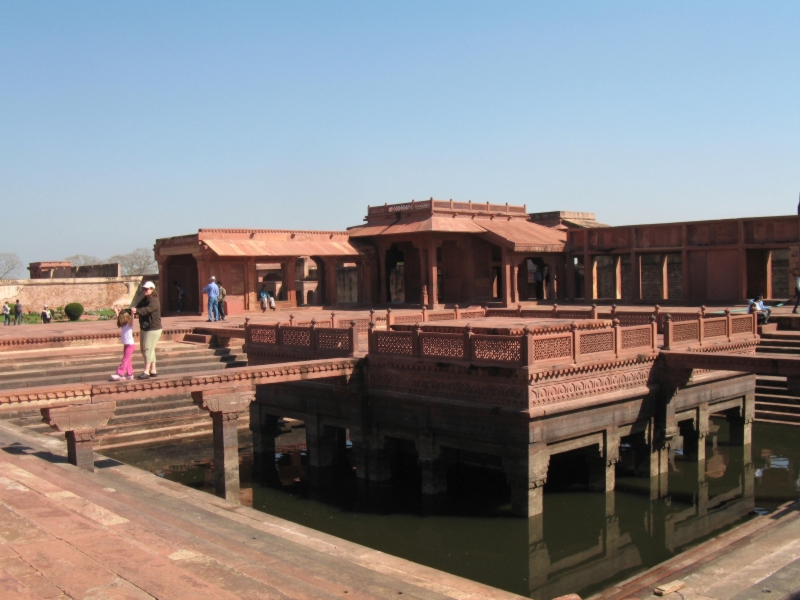Delhi to Agra: "Vrindavan, Akbar"
The Golden Triangle - First Leg
Agra
Uttar Pradesh
India
February 13, 2007
Dear Geometric-philes,
The most popular itinerary for first time visitors to India is The Golden Triangle: Delhi south to Agra, Agra west to Jaipur, and Jaipur northeast to Delhi. On a map of the Indian Subcontinent, this area is barely more than a thumb print or two. Nevertheless, the sights are splendid all along the route.
At the vertex of the triangle is New Delhi. Two of my favorite spots are the Purana Qila (Old Fort) and the Lodi Gardens.
The Old Fort is old. The site has been occupied since 1000 BC. The old walls and the decorated buildings sit in an expansive park with good views and a peaceful atmosphere. Young couples find little hideaways beside trees or shrubs or out of sight walkways for their private conversations and maybe even a little handholding. On the grounds of the fort are the Qila-I-Kuhran Mosque and the Sher Mandal, a small, octagonal, red sandstone tower used as a library.
I expected to see gardens at the Lodi Gardens. True, it is a picturesque park, the "green lung" of New Delhi with tree-lined pathways and well-kept lawns and flowerbeds. What I did not expect was a group of imposing 15th century tombs and mosques of the Sayyid and Lodi dynasties.
I hang around at these tombs with lots of other tourists.* The fine art work and architecture and the green open space is a unique and playful combination.
The first leg of the Golden Triangle, Delhi to Agra is equally green and imposing. The green in this area are endless fields of yellow-flowered mustard plants, a welcome contrast to the streets of Delhi.
I ask Suresh to stop at a totally non-tourist, yet important pilgrimage spot called Vrindavan. The Krishna community comes here from all over the world. Westerners, Hari Krishnas, attend courses at a temple complex. I found the Govind Dev Temple (1590.). The mysterious interior has intricate red sandstone pillars and ceilings.
Akbar's Mausoleum is just 10k north of Agra:
"This outstanding sandstone and marble tomb commemorates the greatest of the Mughal emperors. The huge courtyard is entered through a stunning gateway. It has three-storey minarets at each corner and is built of red sandstone strikingly inlaid with white marble geometric patterns."
"The tomb itself lies in the center of a peaceful garden where deer graze, monkeys play in the tress, and raucous peacocks and parakeets also make their presence felt." **
Suresh and I arrive at the hotel in the evening. The receptionist confirms I have "Taj View." I look and look and look some more but the rain and the mist are all I can see. I will have to wait until the morning to visit Mumtaz Mahal and Shah Jahan.
Pleasant dreams,
Jan
* When I use the word "tourists" I am not just talking about other Westerners. India has a population of more than one billion one hundred million. Most of the tourists I meet are Indian tourists who want to see their enormous country.
Northern India covers 2,331,318 sq km (900,127 sq miles). Much smaller Southern India covers 955,945 sq km (369,092 sq miles). This "smaller" area is larger than France and Germany combined.)
** "India." Lonely Planet. 2005.


Comments
Caroline (not verified)
Thu, 04/21/2016 - 23:06
Permalink
I am extremely impressed
Caroline (not verified)
Thu, 04/21/2016 - 23:06
Permalink
I am extremely impressed
Add new comment